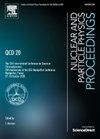Bjorken polarised sum rule with IR-finite QCD coupling
Q4 Physics and Astronomy
Nuclear and Particle Physics Proceedings
Pub Date : 2024-10-08
DOI:10.1016/j.nuclphysbps.2024.09.003
引用次数: 0
Abstract
We evaluate the Bjorken polarised sum rule (BSR) with truncated Operator Product Expansion (OPE) up to the dimension terms; the leading-twist () contribution is evaluated with a renormalon motivated resummation, where we use the IR-finite running coupling free of Landau singularities. The free residue parameters at the and terms are then extracted by fits to the experimental BSR data. In comparison to the case when perturbative QCD coupling is used in this approach (cf. Refs. [1], [2]), many advantages become manifest in the present case: (a) no regularisation in the resummation integral is needed; (b) the -interval in the fit can be significantly extended to lower -values; (c) the extracted residue parameter values are more stable, this being reflected in the significantly reduced experimental uncertainties of these values and the suppressed (almost negligible) central extracted value of the residue parameter ().
具有红外无限 QCD 耦合的 Bjorken 极化和则
我们用截断的算子乘积展开(OPE)来评估比约肯极化和规则(BSR)Γ‾1p-n(Q2),直到维数 D=4 项;前旋(D=0)贡献用重正子激励重和进行评估,其中我们使用了没有朗道奇点的红外无限运行耦合。然后通过拟合 BSR 实验数据提取 D=2 和 D=4 项的自由残差参数。与在这种方法中使用微扰 QCD 耦合的情况相比(参见文献 [1], [2], [3], [4], [5], [6], [7], [8], [9], [10[1],[2])相比,本方法有许多优点:(a)不需要在重和积分中进行正则化;(b)拟合中的 Q2-区间可以显著扩展到更低的 Q2-值;(c)提取的残差参数值更加稳定,这体现在这些值的实验不确定性显著降低,以及 D=4 残差参数(μ6)的中心提取值被抑制(几乎可以忽略不计)。
本文章由计算机程序翻译,如有差异,请以英文原文为准。
求助全文
约1分钟内获得全文
求助全文
来源期刊

Nuclear and Particle Physics Proceedings
Physics and Astronomy-Nuclear and High Energy Physics
CiteScore
0.40
自引率
0.00%
发文量
0
期刊介绍:
Nuclear and Particle Physics Proceedings is the premier publication outlet for the proceedings of key conferences on nuclear and high-energy physics and related areas. The series covers both large international conferences and topical meetings. The newest discoveries and the latest developments, reported at carefully selected meetings, are published covering experimental as well as theoretical particle physics, nuclear and hadronic physics, cosmology, astrophysics and gravitation, field theory and statistical systems, and physical mathematics.
 求助内容:
求助内容: 应助结果提醒方式:
应助结果提醒方式:


